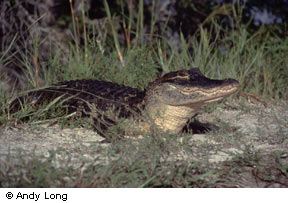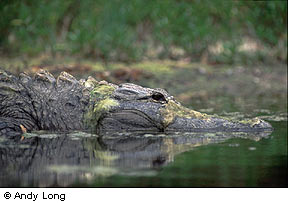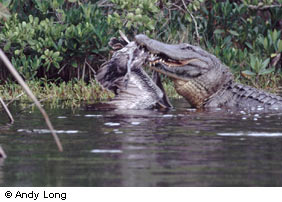 When thinking about animals and how they impact a particular habitat, probably the first to come to mind is the beaver and the dams they create flooding areas to create their own swimming pool and restaurant. Although they cause more changes than most, they are not the only form of wildlife to do this. Another animal that does this is the American alligator as they do their own water management control, creating deep-water pools called “alligator holes.”
When thinking about animals and how they impact a particular habitat, probably the first to come to mind is the beaver and the dams they create flooding areas to create their own swimming pool and restaurant. Although they cause more changes than most, they are not the only form of wildlife to do this. Another animal that does this is the American alligator as they do their own water management control, creating deep-water pools called “alligator holes.”
On occasion, alligators will move into existing holes at the downstream end of a slough or into an acid-created pothole on a tree island, but more often than not they create these holes by digging one where their instinct tells them the water table is close to the surface. They enlarge and deepen their holes by breaking the ground with their powerful tails and using their snouts to shovel debris up onto the rim of the pool.
This action benefits the whole area. Over time, a dense thicket of willows and other plants begin growing on this tossed-up mulch. While beneficial to the habitat, this is not the main reason the alligators create these holes.
The pools are much like a beaver pond in that other animals are attracted to the area. By keeping the center open and free of choking vegetation, this open water attracts fish, frogs and other edibles, which in turn attract birds and mammals that also become part of the alligators’ menu.
 These alligator pools, during the very dry times of the year, can remind you of the water holes in the African Serengeti. These are excellent areas to look for when out shooting in locations such as the Everglades as you can see concentrations of raccoons, river otters, spiny softshell turtles and a wide variety of snakes and waterbirds.
These alligator pools, during the very dry times of the year, can remind you of the water holes in the African Serengeti. These are excellent areas to look for when out shooting in locations such as the Everglades as you can see concentrations of raccoons, river otters, spiny softshell turtles and a wide variety of snakes and waterbirds.
Without these alligator holes, many groups of fish and aquatic invertebrates would not be able to withstand the droughts, thus they are able to wait these periods out and emigrate in the spring to repopulate the flooded plains.
Alligator holes are not the only unique behavior offered up by these animals that have survived from pre-historic times. After mating, the females build a nest that rivals any in the natural world using decaying vegetation as a natural composter where the heat of the decomposition keeps the eggs warm.
The female begins the process by clearing a site for her nest by tearing vegetation out by the roots, mashing it down or scissoring it off with her large jaws. She then piles the vegetation into a cone-shaped mound, using her snout and tail to push it tightly into place.
She makes frequent trips to the nearby water to gather additional water plants to build up the cone, which she finally levels at the top. Then, to form a bowl-shaped hollow in the top of the mound, she begins to pinwheel on her belly, pushing off with one foot. Into the hollow, she packs mud and more aquatic plants until it is filled to the top again.
She then hollows out a small depression in this liner, just large enough to lay her eggs, which number between 25 and 60. Using debris she has pulled from the nest, she covers the eggs and then smoothes the large cone with her body.
When finished, the nest measures 5-7 feet in diameter and 1 1/2 to 3 feet high.
The eggs incubate for nine weeks, with the female standing guard nearby. NOTE – Although coming across one of these nests may give you some interesting photo opportunities be careful as the females are very protective and more dangerous now than at any other time and will attack without notice.
 The compost serves a vital role in the birthing process. Research has found that if the eggs are kept below 86 degrees F they will all turn out female and if kept above 93 degrees F they will all be male. The female helps control the temperature of the nest by alternately letting it dry out and wetting it. More often than not she does a good job as most broods appear to be an even mix of males and females. The 8″ to 10″ hatchlings stay with their mother for up to a year and a half until they reach adult size.
The compost serves a vital role in the birthing process. Research has found that if the eggs are kept below 86 degrees F they will all turn out female and if kept above 93 degrees F they will all be male. The female helps control the temperature of the nest by alternately letting it dry out and wetting it. More often than not she does a good job as most broods appear to be an even mix of males and females. The 8″ to 10″ hatchlings stay with their mother for up to a year and a half until they reach adult size.
Behavior
DIET – Their primary food is fish, but they also eat waterfowl and small mammals that venture next to the water’s edge. You can also see them under heron colonies, waiting for a nestling to fall out of the nest and into the water.
When eating a meal underwater they are able to seal their air passage with their tongue so as not to drown while eating. If their prey is too large to be swallowed on a single gulp, they may shake it violently until it breaks apart.
CALL – Male alligators have a throaty, bellowing roar during breeding season. As he roars, glands under his chin spray out a musky fluid that can be smelled by other alligators for several miles. The female bellows too, but not as loudly as the male. Young alligators have more of a muted moaning type of grunt.
Hot Spot
A trip to Myakka State Park in southwest Florida will provide you with all of the alligators you’ll ever want to find. Just after you enter the park look around the bridge area as they can be found here at most any time of the day as well as many other shoreline locations, especially near the boat docks. Myakka State Park is located off of I-75 south of Sarasota.
By Andy Long

Leave a Reply